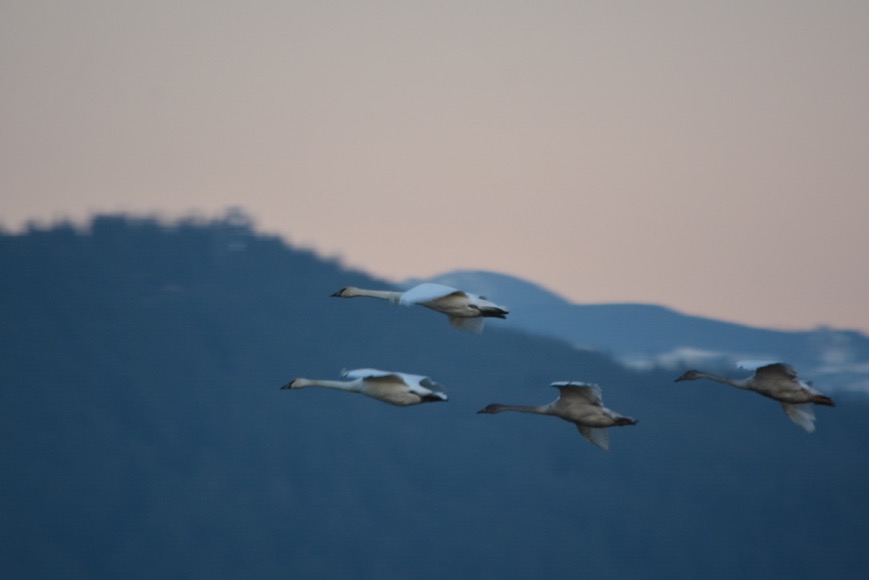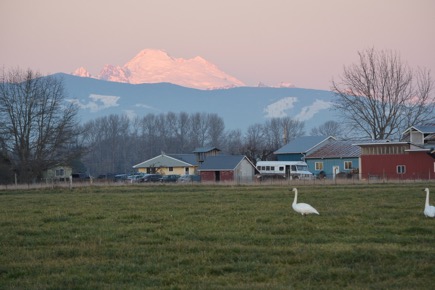Swans
17/12/22 01:24

One of the dramatic parts of the place we live is that during the winter, the area where we live has more trumpeter swans than any other area on the mainland. There are at least and estimated 15,000 trumpeters, most of them in Skagit and Whatcom counties. There are plenty of other birds who are part-time and full-time residents. This is the only place we have ever lived where hummingbirds are present in the winter. We don’t see them as often as we do in the spring when the trees and shrubs are blooming, but we will occasionally spot a hummingbird in one of our bushes that retains its leaves over the winter. When it dips below freezing, this seems like a pretty cold place for a bird that requires so many calories to keep going, but here they are.
We are also fascinated by the shore birds. We’ve never had much opportunity to watch oyster catchers or cormorants or scoters. The bay is often full of brants and loons and grebes and guillemots. We are learning to spot auklets and murrelets and occasionally get the treat of seeing tufted puffins and goldeneyes. We like to watch the sandpipers on the shore
There are plenty of birds that we see here that we also saw in South Dakota, at least part of the year. Seagulls seem to appear everywhere, but there are lot more of them here. They are the raiders of garbage cans on garbage day. Crows are abundant and entertaining to watch. They are intelligent and clever. We live very close to a Great blue heron rookery. The large birds that are often seen standing in shallow water fishing nest in trees and make rather awkward landings when they are up in the trees. Having grown up in a place and a time when sightings of bald eagles was rare, we loved every sighting we made when we lived in South Dakota and took note of the nesting places. We love to watch the bald eagles here as well. We have heard of a place where as many as 200 eagles gather during the salmon run and hope to get up to see them next year.
Of course there are plenty of Canadian geese. The field just to the south of our neighborhood is often full of the geese raising their usual ruckus. Being so close to the border we joke about them having snuck across the border and, possessing no green cards, spending their days being unemployed. Of course they are employed in feeding and preparing for spring’s journey farther north to their breeding grounds. And birds never have acknowledged the borders of which we humans make such a big deal. Others might disagree, but I like the sound of the geese and I can’t help looking up whenever they fly over.
But the sound that always gets my attention whenever I hear it is the call of the trumpeter swans. The first pair that I spot each autumn is extra special. We almost always see them in pairs and often in much larger groups. I’m not completely convinced that their call sounds much like the instrument that shares their name, but it is distinctive. I don’t confuse them with geese or other noisy flyers. Their long necks make them appear sleek and aerodynamic as they glide and their large wings spread broadly for landing. They are magnificent birds and we are so fortunate to have them for neighbors.
I don’t think that the call of the trumpeters is a “sawn song,” but it does make me think of the phrase. The phrase swan song is ancient and permeates our culture. It seems to be everywhere. It can be found in the works of Plato, Aristotle, Euripides and Cicero. It appears in several of Shakespeare plays. The metaphor referring to a final gesture before retirement came up several times as we announced our retirement from our jobs in South Dakota and prepared to move out west. I didn’t get much chance at what I might have called a swan song because covid changed the life of the church so dramatically, so sometimes I think of our current job as Interim Ministers of Faith Formation as our swan song. Instead of a song, I’m enjoying telling ancient faith stories to children.
The folklore that gave rise to the myth appears to be based in fantasy and imagination more than in reality. Swans don’t sing more beautifully or at more length just before they die. Their calls function to keep the pair or family together. Both males and females issue similar sounds that aren’t too much different from the calls of Canadian geese. I’ve heard that juvenile swans have a higher pitched call, but I don’t know that I have ever heard it. By the time they get back here to spend the winter, most of the year’s hatchlings are old enough to have developed the deeper calls of their parents.
I know that the communication patterns of migrating birds are more complex that can be discussed in a brief journal entry, but I like to think of the function of the calls to keep couples or families together. It seems endearing to think that they recognize the distinctions between individuals and know the sound of their mate when flying or when alarmed and taking off from a feeding place.

We have much to learn about the birds of our area, and there is much enjoyment to be gained from watching them while we are learning.
